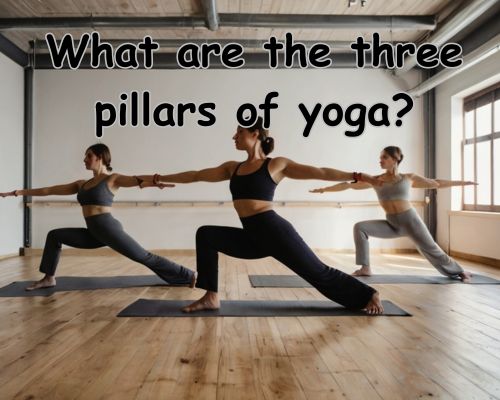Yoga is more than just a physical exercise; it is a comprehensive discipline that balances the mind, body, and spirit. Whether you are practicing at one of Mornington’s serene yoga studios or by the calming waters of Mills Beach, understanding the three pillars of yoga is essential for deepening your practice. But what exactly are these three foundational elements, and why are they crucial to achieving holistic well-being? Let’s have it with Jane Benson of Bikram Yoga Mornington.

Understanding the Three Pillars of Yoga
Yoga is traditionally built upon three primary pillars: Asana (physical postures), Pranayama (breath control), and Dhyana (meditation). Each pillar serves a unique purpose in cultivating balance, mindfulness, and inner peace. Let’s explore these elements in more depth and how they can enhance your yoga journey in Mornington, Australia.
1. Asana (Physical Postures)
Asana refers to the physical postures practiced in yoga. These poses are designed to strengthen the body, improve flexibility, and enhance overall well-being. Whether you are attending a Hatha yoga class in Mornington Peninsula or practicing Vinyasa flow at home, asanas play a crucial role in aligning the body and preparing it for deeper meditative states.
Some popular asanas include:
- Tadasana (Mountain Pose) – Perfect for grounding and improving posture.
- Downward-Facing Dog (Adho Mukha Svanasana) – A staple in many yoga sequences, enhancing flexibility and strength.
- Savasana (Corpse Pose) – Essential for relaxation and integrating practice.
Many yoga studios in Mornington, such as Soul Space Yoga and Hot Hut Yoga, offer classes tailored to beginners and advanced practitioners alike. Attending regular classes ensures proper alignment and progression in your yoga journey.
2. Pranayama (Breath Control)
Pranayama, the art of breath control, is a fundamental aspect of yoga that influences both mental and physical well-being. In Sanskrit, ‘Prana’ means life force, and ‘Ayama’ means extension or control. Various breathing techniques help regulate emotions, reduce stress, and enhance oxygen flow to the brain.
Some effective Pranayama techniques include:
- Nadi Shodhana (Alternate Nostril Breathing) – Helps balance the nervous system and improve focus.
- Kapalabhati (Skull Shining Breath) – Detoxifies the lungs and increases energy levels.
- Ujjayi Breath (Victorious Breath) – Commonly used in Vinyasa yoga to maintain breath awareness.
Mornington’s coastal environment provides an ideal setting for Pranayama practice. Practicing deep breathing while watching the sunrise over Port Phillip Bay can elevate your yoga experience and deepen your connection to nature.
3. Dhyana (Meditation)
Meditation is the third and most profound pillar of yoga, designed to cultivate mindfulness, inner peace, and spiritual awareness. While asana prepares the body and pranayama regulates energy, Dhyana enables deep contemplation and self-discovery.
Types of meditation commonly practiced in Mornington’s yoga community include:
- Guided Meditation – Led by instructors at studios like Yoga Flame Mornington, ideal for beginners.
- Mindfulness Meditation – Encourages present-moment awareness and stress reduction.
- Chakra Meditation – Focuses on balancing the body’s energy centers.
Practicing meditation regularly can significantly improve mental clarity, reduce anxiety, and promote emotional well-being. Many locals find that meditating at The Briars Park or the Mornington Botanical Rose Gardens enhances their experience due to the peaceful surroundings.
Why These Three Pillars Are Essential
Integrating all three pillars—Asana, Pranayama, and Dhyana—creates a well-rounded yoga practice that nurtures both the body and the mind. While some may focus solely on physical postures, incorporating breath control and meditation ensures a deeper and more fulfilling experience. Yoga practitioners in Mornington Peninsula often find that a holistic approach leads to better flexibility, improved concentration, and a greater sense of inner peace.
How to Incorporate the Three Pillars into Your Daily Routine
- Start with Asana – Dedicate at least 15–30 minutes daily to practicing yoga postures.
- Practice Pranayama – Spend 5–10 minutes on breathwork exercises to regulate energy and focus.
- End with Meditation – Conclude your practice with 10 minutes of mindfulness meditation.
By weaving these elements into your routine, you will cultivate a stronger and more sustainable yoga practice.
Finding Yoga Classes in Mornington, Australia
If you are looking to deepen your practice with professional guidance, Mornington offers a range of yoga studios and wellness centers, such as:
- Yoga Flame Mornington – Specializes in various yoga styles, from Vinyasa to Yin yoga.
- Hot Hut Yoga – Offers heated classes for those looking to challenge their practice.
- Soul Space Yoga – Ideal for beginners and advanced yogis seeking community and support.
Additionally, outdoor yoga sessions at Mornington Park and beachside retreats provide unique opportunities to practice in a natural, serene environment.
Conclusion
The **three pillars of yoga—Asana, Pranayama, and Dhyana—**form the foundation of a complete and enriching yoga practice. Whether you are practicing at home, attending classes in Mornington, or meditating by the shore, incorporating these elements will enhance your physical, mental, and spiritual well-being. By embracing this holistic approach, you can experience the true essence of yoga and its transformative benefits.
If you’re in Mornington, Australia, and looking to embark on or deepen your yoga journey, consider exploring local studios or with Jane Benson of Bikram Yoga Mornington, connecting with the community, and immersing yourself in the tranquil surroundings to make your practice truly fulfilling.